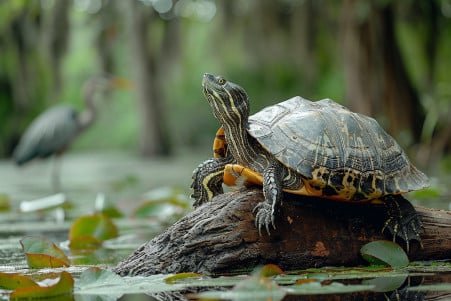From Algae to Carrion: The Many Different Diets of Wild Turtles
4 May 2024 • Updated 3 May 2024

If you've ever wondered what wild turtles eat in the wild, you may not realize just how diverse their diets can be, including everything from aquatic plants and insects to small fish and even carrion. Wild turtles are omnivorous, eating both plant and animal matter. Their diet consists largely of aquatic vegetation, algae, insects, worms, snails, crustaceans, fish and sometimes carrion depending on the species and their environment.
This article will delve into a wealth of studies from various biological and ecological disciplines that detail the specific feeding behaviors and dietary choices of the many different species of turtles that live in lakes, rivers, wetlands, and oceans all over the globe. Learning about the diets of wild turtles will help you better understand the important roles these reptiles have in aquatic ecosystems.
What do wild turtles eat?
Juvenile Turtles’ Dietary Needs and Feeding Behavior
Juvenile turtles have much higher protein needs than adults because they are growing so quickly. As BioExplorer.net notes, baby turtles in the wild eat a range of small, protein-rich aquatic prey, including insects, insect nymphs, tadpoles, and small shrimp. Some, like the green sea turtle, are even omnivores, according to HowStuffWorks, eating both plants and animals until they become herbivores as adults.
This is especially important for healthy shell development. As noted in a post on TurtleForum, juvenile turtles are opportunistic feeders, eating whatever food is available in their freshwater or marine habitats. They are not picky eaters. Juvenile turtles eat a more carnivorous diet than adults of the same species, according to King British, and this change in diet helps them get the nutrition they need at each stage of development.
Sea Turtle Diets in the Ocean
Sea turtles have a diverse array of dietary specializations that depend on their species and the marine environment they inhabit. Green sea turtles are almost exclusively herbivorous, eating seagrasses and algae as adults, notes SeaWorld. Hawksbill turtles are spongivores, meaning their jaws are adapted to eat marine sponges, which makes them one of the few animals that can eat this food source, notes the Olive Ridley Project. Leatherbacks are gelatinivores, meaning they specialize in eating jellyfish and other soft-bodied prey, reports WWF.
On the other hand, loggerheads, ridleys, and flatbacks are more generalist, omnivorous eaters that consume a variety of marine life in their environments, according to the Olive Ridley Project. These different feeding styles enable sea turtles to live in a range of marine environments, from coral reefs to the open ocean.
Feeding Behaviors and Strategies of Turtles in the Wild
Turtles use a range of behaviors to find, catch, and eat their prey or plant-based food. For example, many aquatic turtles use their tongues to attract small fish and other animals into their mouths so they can swallow them whole, says Pets on Mom.com. Their sharp beaks and strong jaw muscles enable them to bite off pieces of food, including tough plants.
Meanwhile, land turtles like the Eastern box turtle, per the National Wildlife Federation, eat insects, berries, flowers, and other food they find on the ground. In addition, some turtles, such as the leatherback sea turtle, are migratory and travel long distances to find areas where they can feed on jellyfish, according to Live Science.
Turtle feeding behaviors often change as turtles grow from juveniles to adults. For example, Live Science explains that turtles are often more carnivorous when they are young and may become herbivorous or omnivorous as they age. These different feeding strategies help explain how turtles are able to live in so many different aquatic and land-based ecosystems.
Water and Hydration for Wild Turtles
Wild turtles in their natural environments get their water from a variety of sources including ponds, lakes, rivers, and rainwater, according to WildlifeNYC. Aquatic turtles can also take in water and oxygen through their skin while they are underwater or hibernating, as explained by the PBS article on turtle hibernation. Terrestrial turtles like the Eastern box turtle may depend more on dew, the moisture in their food, and infrequent rain for hydration, notes the National Wildlife Federation.
Freshwater ecosystems are essential for the survival of turtles, providing water and food, as highlighted by the Florida Fish and Wildlife Conservation Commission. However, human activities such as habitat loss and water pollution can impact turtles' access to clean water, according to the U.S. Fish & Wildlife Service. It is important to protect these critical aquatic ecosystems to help ensure the future of the many different turtle species.
Wild Turtles’ Ecological Roles and Their Diets
Turtles are important to the health and stability of the ecosystems they inhabit. For example, green sea turtles are considered a keystone species because they help maintain seagrass beds, which are important for many other marine species.
Meanwhile, leatherbacks, per WWF, help keep jellyfish populations in check, which is important because jellyfish can outcompete other marine life. Freshwater turtles help with nutrient cycling by eating aquatic plants and animals, says the U.S. Fish & Wildlife Service. Understanding what turtles eat can help researchers understand their role in their ecosystems and how to best protect them.
Conclusion: Understanding the Varied Diets of Wild Turtles
The diets of wild turtles are incredibly diverse, with turtles eating everything from aquatic plants and algae to insects, crustaceans, fish, and even carrion. This diversity is driven by a variety of species-specific adaptations and preferences. Understanding their diets provides insights into the crucial ecological roles turtles play in maintaining the health and balance of aquatic ecosystems.
Protecting turtle habitats is essential for ensuring their access to appropriate food sources and clean water. Further research can deepen our knowledge of turtle diets and their broader impact. Appreciating the complexity of wild turtle diets fosters a greater respect for these ancient reptiles that have roamed the Earth for over 200 million years.


